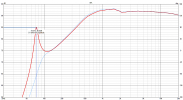They are!I would not recommend those for these values indeed. Stil, bipolar caps aren’t exactly super cheap with those voltages.
just a few pounds each, as opposed to £20 or more for plastic ones. (10uF +)
They are!I would not recommend those for these values indeed. Stil, bipolar caps aren’t exactly super cheap with those voltages.
Lovely.Out of curiosity, as the crossover network was quite a complex one, I created a circuit model of the Sasandu TX crossover in VituixCAD. In this crude first approximation, I've simply used the voice-coil resistance of each driver as its impedance, and assumed that each driver has a perfectly flat frequency response.
The crossover circuit is shown below:
View attachment 316663
The resulting filtered frequency response curves of the dummy woofer, midrange and tweeter are shown below:
View attachment 316665
The impedance curve obtained with the drivers approximated as constant resistance values is shown below:
View attachment 316667
The manufacturer's response curve for this "midrange" driver is shown below:... a 50Hz possible glitch on a midrange driver...
For me! Bypassing the 900uF caps, rules the day. I very much doubt, if it is going to be audible, but it would save 6x£5=£30.The manufacturer's response curve for this "midrange" driver is shown below:
View attachment 316679
This driver is a midwoofer, and that 50Hz region should exclusively involve textbook pistonic cone motion. I'm unsure what the measured frequency response curve is actually showing in that low-frequency region. The impedance curve shows no indication of any unusual behavior at 50Hz.
The LCR filter (with 900µF) in the crossover for the midrange driver is most likely indispensable - as @solderdude and @Wolf already hinted.For me! Bypassing the 900uF caps, rules the day. I very much doubt, if it is going to be audible, but it would save 6x£5=£30.


Hi SC,
the crossover looks like it is done by Daniel Gattig......the parts look like one of his designs. As he knows well what he is doing, it's not wrong to follow it.
Here is the link to the shop in Germany: Lautsprechershop…
Hi everyone,
Many thanks for all the comments and guidance, it is most appreciated.
Ive actually decided to park the project following the purchase of an ADI-2 DAC/Amp (blame ASR and @amirm) This little box has made me appreciate headphone listening all over again and I’m questioning the need for anything else (I know, a crazy idea)
To be honest, a joiner friend is helping/teaching/rescuing me with the cabinets so the project will continue on that front, for now, as Im enjoying the woodworking.
SC
